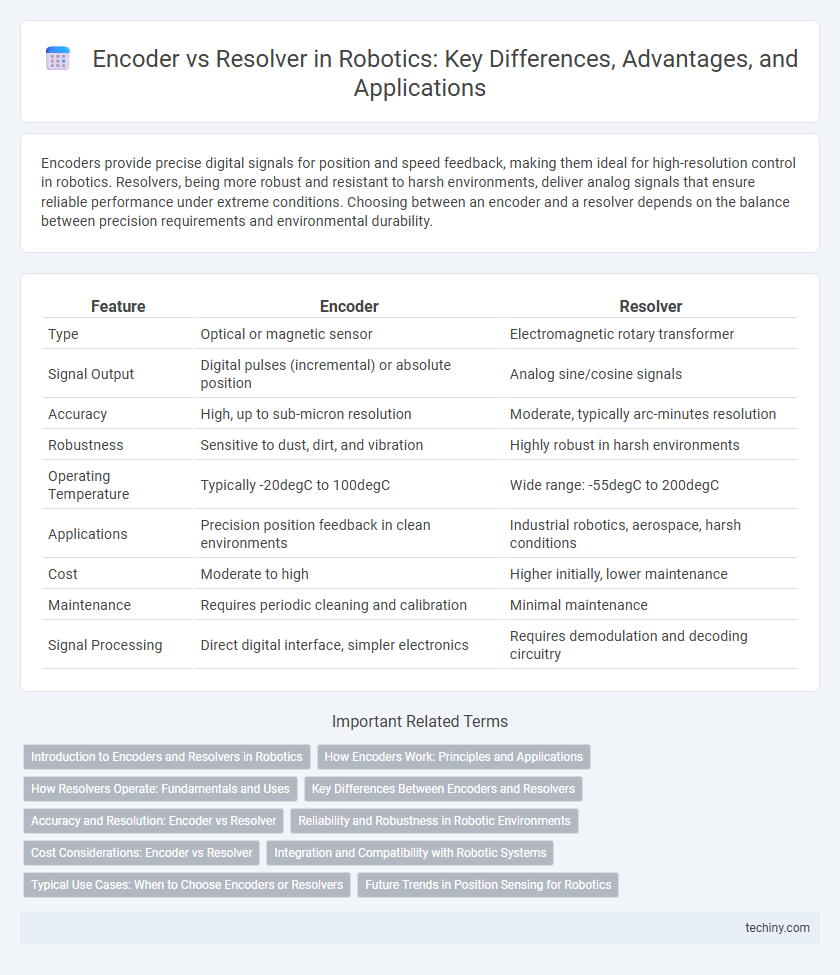Encoders provide precise digital signals for position and speed feedback, making them ideal for high-resolution control in robotics. Resolvers, being more robust and resistant to harsh environments, deliver analog signals that ensure reliable performance under extreme conditions. Choosing between an encoder and a resolver depends on the balance between precision requirements and environmental durability.
Table of Comparison
| Feature | Encoder | Resolver |
|---|---|---|
| Type | Optical or magnetic sensor | Electromagnetic rotary transformer |
| Signal Output | Digital pulses (incremental) or absolute position | Analog sine/cosine signals |
| Accuracy | High, up to sub-micron resolution | Moderate, typically arc-minutes resolution |
| Robustness | Sensitive to dust, dirt, and vibration | Highly robust in harsh environments |
| Operating Temperature | Typically -20degC to 100degC | Wide range: -55degC to 200degC |
| Applications | Precision position feedback in clean environments | Industrial robotics, aerospace, harsh conditions |
| Cost | Moderate to high | Higher initially, lower maintenance |
| Maintenance | Requires periodic cleaning and calibration | Minimal maintenance |
| Signal Processing | Direct digital interface, simpler electronics | Requires demodulation and decoding circuitry |
Introduction to Encoders and Resolvers in Robotics
Encoders and resolvers are critical components in robotics for precise position and speed feedback. Encoders convert rotational or linear motion into digital signals using optical or magnetic sensing methods, offering high resolution and accuracy. Resolvers use electromagnetic induction to provide robust, analog signals ideal for harsh environments requiring reliable angular position detection.
How Encoders Work: Principles and Applications
Encoders operate by converting mechanical motion into electrical signals through optical or magnetic sensing, enabling precise position and speed feedback in robotic systems. Optical encoders use a rotating disk with patterned lines read by a photodetector, while magnetic encoders detect changes in magnetic fields caused by shaft rotation. Their high-resolution output supports accurate motor control, trajectory planning, and synchronization in automation and robotics applications.
How Resolvers Operate: Fundamentals and Uses
Resolvers operate through electromagnetic induction principles, converting angular position into analog electrical signals using a rotor winding and two stator windings displaced by 90 degrees. Their robust design offers immunity to harsh environments, providing precise feedback for motor control in aerospace, military, and industrial robotics applications. Unlike optical encoders, resolvers excel in high-temperature conditions and where vibration and contamination are prevalent, ensuring reliable performance in challenging robotic systems.
Key Differences Between Encoders and Resolvers
Encoders provide precise digital signals for position and speed feedback using optical or magnetic sensors, while resolvers generate analog signals based on electromagnetic induction, offering higher durability in harsh environments. Encoders excel in applications requiring high resolution and accuracy but are more sensitive to dust and vibrations, whereas resolvers perform reliably in extreme conditions with lower resolution. Cost and complexity also differ, with encoders generally being more affordable and easier to integrate compared to the robust but complex resolver systems.
Accuracy and Resolution: Encoder vs Resolver
Encoders provide high-resolution feedback with precision levels often reaching fractions of a degree, making them ideal for applications demanding exact position measurements in robotics. Resolvers offer robust accuracy in harsh environments, maintaining reliable angular position data through electromagnetic induction but generally have lower resolution compared to optical encoders. The choice between encoder and resolver hinges on the trade-off between the need for ultra-high resolution and environmental durability in robotic systems.
Reliability and Robustness in Robotic Environments
Encoders offer precise position feedback with high resolution but can be vulnerable to dust, vibration, and electrical noise in harsh robotic environments. Resolvers, with their rugged electromagnetic design, provide superior reliability and robustness under extreme temperature, dirt, and mechanical shock conditions. Choosing between encoders and resolvers depends on the specific environmental challenges and performance requirements of the robotic application.
Cost Considerations: Encoder vs Resolver
Encoders generally offer lower upfront costs compared to resolvers, making them cost-effective for applications with budget constraints. Resolvers, while more expensive initially, provide higher durability and better performance in harsh environments, reducing long-term maintenance expenses. Choosing between encoder and resolver involves balancing initial investment against reliability and operational costs over the device's lifespan.
Integration and Compatibility with Robotic Systems
Encoders offer straightforward integration with robotic systems due to their standardized digital signals, enabling seamless compatibility with common motion controllers and PLCs. Resolvers provide robust performance in harsh environments but often require additional signal processing hardware, which can complicate integration with certain robotic platforms. Selecting between encoders and resolvers depends on system requirements for precision, environmental conditions, and existing control architecture compatibility.
Typical Use Cases: When to Choose Encoders or Resolvers
Encoders are typically chosen for applications requiring high precision position feedback, such as CNC machines and robotic arms, where digital signals provide accurate and fast response. Resolvers excel in harsh environments with high temperatures, vibrations, or electromagnetic interference, making them ideal for industrial robotics and aerospace systems. Selecting between encoders and resolvers depends on factors like environmental conditions, required accuracy, and system complexity.
Future Trends in Position Sensing for Robotics
Future trends in position sensing for robotics emphasize advancements in encoder and resolver technologies, with increasing integration of high-resolution optical encoders enabling precise motion control in autonomous systems. Magnetic resolvers continue to evolve, offering robust performance under extreme environmental conditions and enhanced fault tolerance crucial for industrial robotics applications. Emerging hybrid sensors combining encoder accuracy with resolver reliability are set to revolutionize feedback systems, driving greater efficiency and adaptability in next-generation robotic platforms.
Encoder vs resolver Infographic

 techiny.com
techiny.com